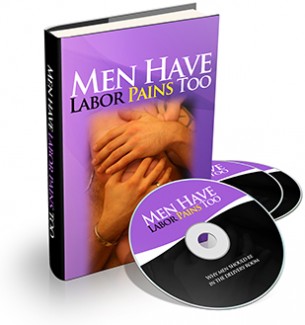 License Type: Private Label Rights
License Type: Private Label Rights  File Size: 65,407 KB
File Size: 65,407 KB File Type: ZIP
File Type: ZIP
 SKU: 52595
SKU: 52595  Shipping: Online Download
Shipping: Online Download
Ebook Sample Content Preview:
Once the woman’s cervix is fully dilated to 10cm, it will be time for her to push. For many guys, this may seem like an easy task. After all, it’s just pushing. Well, remember that a baby is a lot bigger than the hole it’s coming out of. I once heard a comedian say it’s like a man pushing a bowling ball out of his nose.
At any rate, this doesn’t go as quickly as you might think. The delivery part of childbirth is the hardest part – even harder than putting up with the pain of contractions!
This is where your resiliency really comes into play. The big thing men need to remember about delivering a baby is that – well – it’s gross, but beautiful all at the same time. Many guys report that they didn’t mind the contractions and heavy labor, but when it came to the actual delivery, they were completely taken aback.
The most often heard advice in locker rooms when talking about being present during childbirth might be to stay at the head of the bed and don’t look down. It’s a matter of choice, but this is a one time thing, so if you really, really don’t want to watch, don’t. But be aware that you might miss out on something wonderful!
It’s at this time when her legs will be splayed apart and everything God gave her will be exposed. Believe me, she doesn’t care. Her modesty went out the door when the baby bore down in her pelvis trying to get out.
When she is having a contraction is when she should be pushing. The birth attendant will be extremely helpful during this time and listening to them is very important. You will get into a rhythm, though.
The general position for pushing is with the legs apart – big surprise there, huh? She should take a big breath in through her mouth, hold it, put her chin to her chest and bear down. Pardon the description, but it’s like taking a big, huge – um – bowel movement (to be as general about it as we can be!)
Every time she pushes, the baby travels a little further down the birth canal. Breathing during the push causes the baby to “suck back” just a little and impedes the progress, so encourage her to keep pushing as long as she can.
When labor really gets underway, she will be asked to do this three times in a row for 10 seconds at a time. This means the process will be something like this: deep breath, push while you count to ten (one-Mississippi, two-Mississippi, etc.), a short rest and then again two more times. The more she does this, the more progress the baby makes. If she holds her breath, this will provide more strength behind the pushing.
However, there really is no one “right” way to push or breathe. It depends on what her body is telling her. Just be by her side and support whatever adjustments she needs to make in order to make the process progress.
What do you do at this point? Hold her legs behind the knees bringing them up to her chest, count, and encourage! You can’t say “You can do it” enough times. You can also try phrases like “Keep it up”, “You’re doing great”, “That’s the way to do it”, etc.
Some phrases to avoid include “Wow, that’s gross”, “Can’t you do any better than that”, “It can’t be that bad”, and “Get it out for heaven’s sake, Sports Center is coming on”. (Sorry, I just had to inject a little humor there!)
While she’s pushing and you’re counting, the birth attendant will be monitoring the baby’s progress again with the lubed, gloved fingers. They will probably also be making a circular motion around the cervix to make room for the baby.
The doctor may choose to do an episiotomy to help provide a little more room for the baby come out. This isn’t nearly as bad as it seems, but you should know about it.
CUT ME MICKEY!
An episiotomy is done by snipping the bottom of the vaginal opening to enlarge it for birth. With a midline or median episiotomy, the usual type in the U.S. and Canada, the practitioner cuts straight down toward the anus. With mediolateral episiotomy, the preferred type in other parts of the world, the cut slants off to one side. Some U.S. and Canadian caregivers routinely do mediolateral episiotomies, and some do them under certain circumstances such as for forceps deliveries.
Compared with mediolateral episiotomies, midline episiotomies are easier to repair, hurt less afterwards, cause less blood loss, cause fewer complications during healing, give better anatomical results, and are less likely to cause pain during intercourse. However, midline episiotomies are much more likely to extend into or through the anal sphincter.
If the baby is in trouble close to the birth, the doctor or midwife will not want to wait the additional time it may take for the birth without an episiotomy. In some cases a woman is exhausted or not stretching well and the caregiver will recommend an episiotomy. However, unless the birth attendant rarely does episiotomies, that judgment is questionable. If exhaustion is the issue, remember that an episiotomy shortens labor by an average of nine minutes – and that’s a good thing!
Many birth attendants hesitate to do episiotomies. Some believe that they lead to pelvic floor weakness. The pelvic floor is a complex group of muscles that form a hammock suspended between the pubic bone in front and the base of the spinal column in back. The urethra, vagina, and anus all pass through it. Pelvic floor weakness or injury can lead to sexual dysfunction, urinary stress incontinence, and anal incontinence.
However, if the baby just isn’t going to come out with an episiotomy, it become absolutely necessary, and most women heal easily from the procedure with Kegel exercise to strengthen the cut muscle.
There will be some discomfort in the first few days after childbirth even without an episiotomy. It is common for there to be some general soreness or even a small injury to the perineum. However, having an episiotomy will greatly increase the chances of having enough pain to interfere with walking or sitting comfortably. There can also experience intense stinging with urination and moving your bowels can be very uncomfortable for the first few days.
- File Size:65,407 KB
- License: Private Label Rights
- Category:Ebooks
- Tags:2014 Ebooks With Audio Private Label Rights








